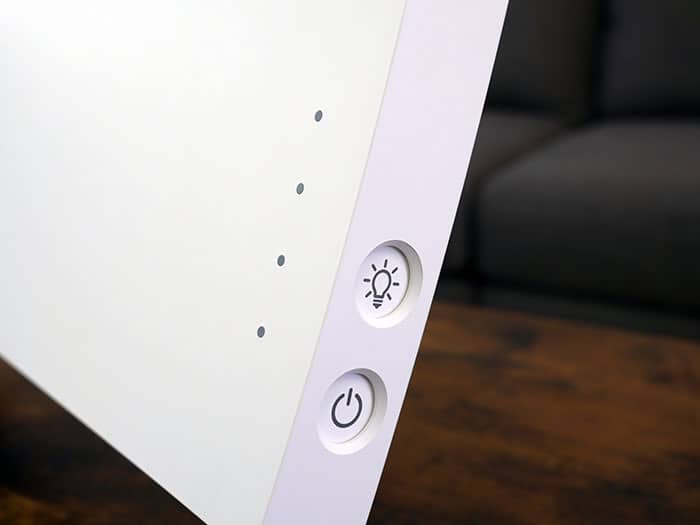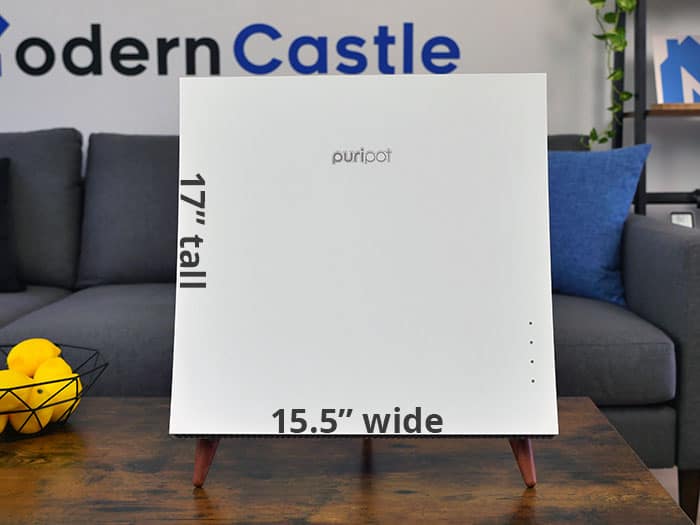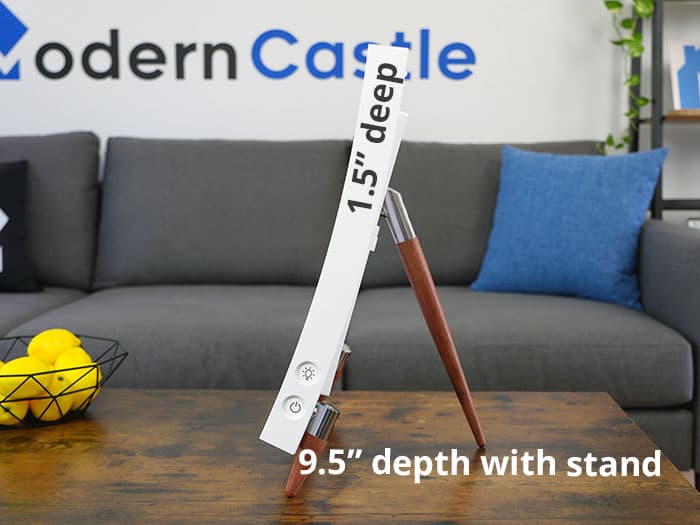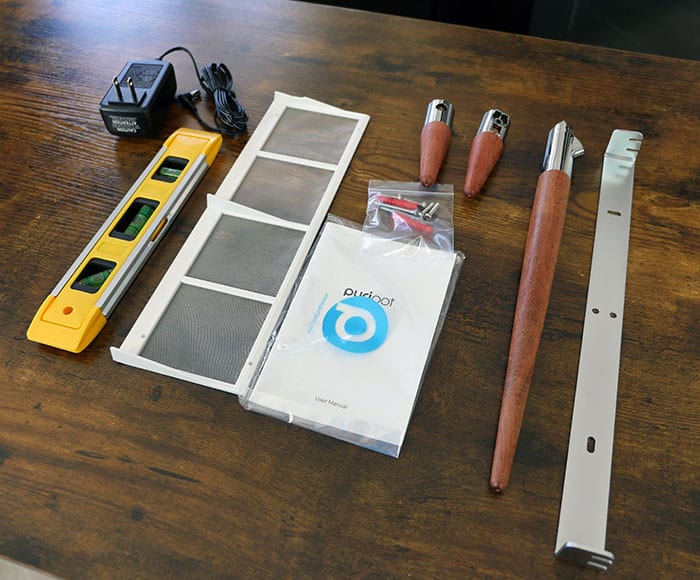The Puripot air purifier takes a new approach to air purification.
Instead of capturing particulate and allergens in a filter that needs to be periodically replaced, the Puripot uses blue light to destroy these particles. As a result, the system is virtually maintenance-free and has no replaceable filter.
Sound too good to be true? Let’s dive in and learn everything we need to know about this unique approach to air purification.
Maintenance-Free Air Purification

Puripot Air Purifier
The Puripot air purifier is not your traditional purifier. It is designed as an air sanitizer and deodorizer. During our tests it did a fantastic job of making the air smell better and felt cleaner, but it doesn’t purify in the same way as a traditional unit would. However, it’s maintenance free and relies on blue-light based PCO technology instead of costly HEPA filters. Check PricePros
- Medium-sized coverage area up to 536 sf.
- Virtually zero maintenance
- Simple setup and use
Cons
- More expensive than other units on the market
- Does not reduce particulate count or improve overall AQI value
Purification Performance
The performance of the Puripot air purifier was impressive, but not in the same way that a traditional air purifier is impressive.

The Puripot is a different design entirely so to judge this system under the same scale as traditional air purifier would likely be doing it a bit of a disservice.
What is it?
This purifier is designed to be a:
- Air Deodorizer
- Air Sanitizer
What is it not?
Among other things, the Puripot isn’t designed to:
- Reduce particulate count
- Improve the overall AQI value
Testing Series
To test the Puripot, we followed the same process we use for all of our air purifiers.

First, we set it up in a medium-sized room in our office. I took a baseline measurement before the start of the test to gauge current air quality. Then, I let the Puripot run for 60 minutes and took another set of measurements.
The difference between the baseline and post-run data gives a complete look at the overall performance.
What were the results?
Starting Baseline
- PM2.5: 4.4
- PM10: 7.3
- Particles: 689
- AQI: 18
After 1 Hour
- PM2.5: 4.3
- PM10: 7.7
- Particles: 759
- AQI: 18
At first glance, it really does appear that the Puripot doesn’t do anything to effectively purify the air. However, that’s not entirely true.
Our tests are designed to see how well a given air purifier reduces particulate count as well as improve the overall AQI.

The Puripot isn’t really designed to do either of these things.
Instead, it is designed as an Air Sanitizer and Air Deodorizer.
Unfortunately, we don’t have an objective way to test for this type of performance, but here’s what I can say…
After running this purifier for an hour in the closed space, there was a huge improvement in the smell of the air.
This purifier is certainly deodorizing and cleaning the air, but not in the same way that we are used to seeing with other purifiers we’ve tested.
Laboratory Tests
Because Puripot’s purification deals in incredibly hard to measure evidence…namely VOCs, viruses, and bacteria, I asked them to provide us with their lab testing data, which they did.


Puripot’s airFrame F1+ was tested by the Korea Testing & Research Institute. Here are the reports they provided:
The test report documents are somewhat limited in their scope, but the findings seem to support the following:
- Puripot was able to reduce and remove a range of VOCs including ammonia, formaldehyde, hydrogen sulfide, and others. This fact enables it to effectively deodorize spaces.
- Puripot removed 73.6% of viruses in the lab test.
- Puripot does not create significant or unsafe quantities of ozone (only 0.009 ppm). NIOSH considers ozone levels of 5 ppm or higher to be unsaufe (source).
- Puripot was able to kill 91% of bacteria within 4 hours and 99% of bacteria in 8 hours.
Puripot Design
The design of the Puripot is unique and really unlike anything we’ve seen. As I mentioned above, it cleans the air in a different way, but it also looks different and works differently too.

This purifier can sit freestanding or be wall-mounted. Once installed, you just plug it in and let it work. It is virtually maintenance-free and extremely user friendly.
How does it work?
Traditional air purifiers use HEPA filtration that captures particulates in a paper-based filter.

Capturing the particles, airborne germs, and allergens and then disposing of the filter is an effective way to clean the air for these types of purifiers.
But the Puripot purifier is different.
Puripot uses blue light ant PCO technology (photoelectrochemical oxidation).
The Controls
The controls are incredibly simple. When you plug the unit in, there are two buttons on the side that you can choose from:
- Mood Light: illuminates an LED light out the bottom of the unit for aesthetics
- Power on / off: turns the unit on or off

Is there a remote control?
There is no physical remote control and the purifier cannot connect to an app.
HEPA vs. PCO
What’s the difference between traditional HEPA and PCO technology? Both technologies are designed to clean the air, but each in a different way.

- HEPA filters use their accordion style filter paper to catch particulate and store them in the filter. Once the filter is full, you simply toss it in the trash and replace it with a new one.
RELATED: What is a HEPA filter?
- PCO technology uses blue light to remove VOCs, bacteria, and viruses. Also unlike HEPA, this light technology has no replaceable filters. Just plug it in and the rest is virtually maintenance-free.

Size & Dimensions
This purifier is about the same height and length as similar air purifiers, but quite a bit narrower.

Here are the exact dimensions for reference:
- Width: 15.5″ wide
- Height: 17″ high
- Depth: 1.5″ deep (unit only); 9.5″ deep overall (unit and stand)
- Weight: 10.7 lbs.

Accessories & Parts
The Puripot F1+ comes with a fairly large collection of parts and accessories.
The exact assortment of items in the box includes:
- Wood stand: three wooden legs with chrome trim holds the purifier up and also does so in an aesthetically pleasing way
- PCO mesh unit: removes larger airborne particulates
- Wall mount: use provided hardware to mount the purifier onto the wall
- Power adapter: plugs into the purifier and a standard wall outlet
- Level: helps to ensure a proper install
- User manual: includes steps for initial setup, maintenance, and troubleshooting

Setup & Usability
The setup for the Puripot air purifier is incredibly easy.
Here are the steps you’ll need to follow after unboxing the system.
- First, unbox the purifier and all parts and accessories.
- Install the pre-filter and the power adapter.
- Plug the power cord into the bottom of the purifier.
- Press the power button to turn the unit on.

That’s all there is to it. There is no wifi connectivity or different modes to choose from. It’s either on or off—simple enough.
Maintenance
One of the most attractive features of the Puripot airFrame is the complete lack of maintenance.
Unlike traditional air purifiers which require you to replace the filter every 6-12 months (depending on use), the Puripot does not require that same level of maintenance.
This system uses two parts—the pre-filter and the PCO light technology, neither of which require replacements.

Is the Puripot a good value?
The value of the Puripot air purifier is mostly good, but only if you understand exactly what it is.
If you’re looking for an air purifier that reduces overall particulate count or improves the air quality index, you will be disappointed by the Puripot, as it does neither of these things.

But if you’re looking for a purifier that noticeably improves the smell of the air and sanitizes the air as well, the Puripot is a good value.
The price point is high, but the most attractive feature of the Puripot is the complete lack of maintenance—no filters to replace and no parts to maintain.
For a quality air purifier, this is really just unheard of and we have yet to test anything quite like it on the market.
Puripot Specifications
| Specifications | Puripot |
|---|---|
| Type | Air Purifier |
| Manufacturer | Puripot |
| Model | airFrame F1N / F1+ |
| Width | 15.5" |
| Height | 17" |
| Depth | 1.5" (single unit); 9.5" (with stand) |
| Weight | 10.7 lbs. |
| Filtration | PCO blue light |
| HEPA Filter | No |
| Returns | Yes (usually), Varies by retailer |
| Warranty | 1-Year limited |
| Price | Check Price |
Should you buy the Puripot airFrame F1+?
Overall, I would say the Puripot air purifier is a great option for people who are looking for cleaner air, but don’t really need reduced particulate count or who specifically don’t want HEPA filtration.
I would recommend the Puripot if you’re looking for an air purifier with the following features:
- No maintenance: The Puripot air purifier does not use traditional HEPA filtration and therefore does not require any filter replacement. Just plug it in and go.
- Better smelling air: While our performance tests showed that the Puripot doesn’t reduce overall particulate count or improve AQI as a traditional air purifier would, I can say the deodorization of the air was extremely impressive. Among all the purifiers we’ve tested the Puripot is arguably the best at improving odors.
- Low profile: At less than 2″ deep (without the stand), this is one of the narrowest air purifiers that we’ve tested to date. It comes with 3 wooden tapered legs or you can mount it on the wall for a low profile look.
For more information or to buy the Puripot air purifier, click here.
Updates
- October 27, 2020 – Corrected an error where we incorrectly labeled the product as the F1N, when it is actually the F1+. We also corrected an error regarding app connectivity (which is only available on the F1N and not the F1+).
- October 26, 2020 – Initial version of the review was published.
Air Sanitizer & Deodorizer
-
Design - 95%
95%
-
Performance - 97%
97%
-
Quality - 95%
95%
-
Usability - 98%
98%
-
Value - 96%
96%
Summary
The Puripot air purifier is a “plug in and go” kind of a unit. It is virtually setup free as well as maintenance-free. There are no complicated modes, just an on/off button and a power cord. It’s also one of the only air purifiers that we’ve tested that doesn’t need replacement filters, as it relies 100% on blue-light-based PCO technology to deodorize and sanitize the air. If you’re looking for a simple air purifier that you don’t have to keep tabs on, the Puripot could be a great option to consider.
